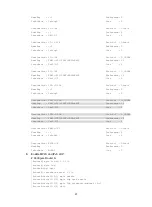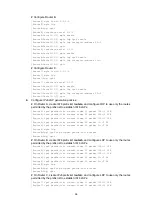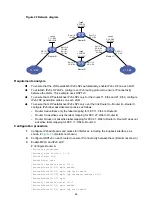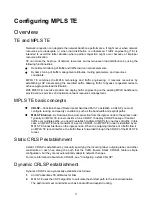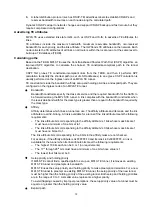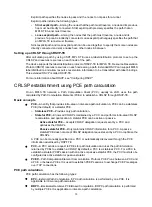
65
Figure 24 Network diagram
Requirements analysis
•
To ensure that the LSRs establish IPv6 LSPs automatically, enable IPv6 LDP on each LSR.
•
To establish IPv6 LDP LSPs, configure an IPv6 routing protocol to ensure IP connectivity
between the LSRs. This example uses OSPFv3.
•
To ensure that LDP establishes IPv6 LSPs only for the routes 11::0/64 and 21::0/64, configure
IPv6 LSP generation policies on each LSR.
•
To ensure that LDP establishes IPv6 LSPs only over the link Router A—Router B—Router C,
configure IPv6 label advertisement policies as follows:
{
Router A advertises only the label mapping for FEC 11::0/64 to Router B.
{
Router C advertises only the label mapping for FEC 21::0/64 to Router B.
{
Router D does not advertise label mapping for FEC 21::0/64 to Router A. Router D does not
advertise label mapping for FEC 11::0/64 to Router C.
Configuration procedure
1.
Configure IPv6 addresses and masks for interfaces, including the loopback interfaces, as
shown in
. (Details not shown.)
2.
Configure OSPFv3 on each router to ensure IP connectivity between them. (Details not shown.)
3.
Enable MPLS and IPv6 LDP:
# Configure Router A.
<RouterA> system-view
[RouterA] mpls lsr-id 1.1.1.9
[RouterA] mpls ldp
[RouterA-ldp] quit
[RouterA] interface serial 1/1/0
[RouterA-Serial1/1/0] mpls enable
[RouterA-Serial1/1/0] mpls ldp ipv6 enable
[RouterA-Serial1/1/0] mpls ldp transport-address 10::1
[RouterA-Serial1/1/0] quit
[RouterA] interface serial 1/1/1
[RouterA-Serial1/1/1] mpls enable
[RouterA-Serial1/1/1] mpls ldp ipv6 enable
Router A
Router B
Router C
Loop0
1.1.1.9/32
100::1/128
Loop0
3.3.3.9/32
100::3/128
Ser1/1/0
10::1/64
Ser1/1/1
20::1/64
Ser1/1/0
10::2/64
Ser1/1/0
20::2/64
11::0/64
21::0/64
GE1/1/1
11::1/64
GE1/1/1
21::1/64
Router D
Loop0
4.4.4.9/32
100::4/128
Loop0
2.2.2.9/32
100::2/128
Ser1/1/1
30::1/64
Ser1/1/1
40::2/64
Ser1/1/0
30::2/64
Ser1/1/1
40::1/64







